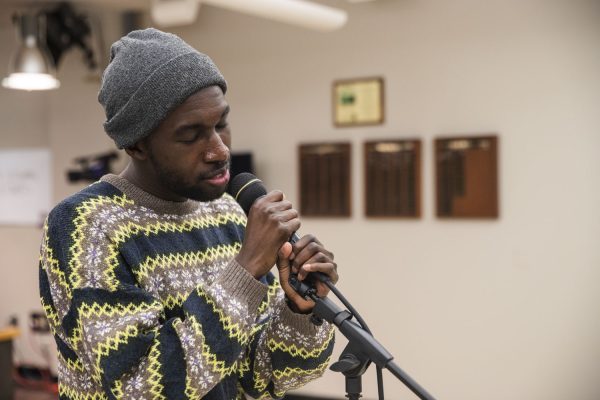Author Mark Mayer walks the tightrope of mystical fiction
Iowa Writers’ Workshop graduate Mark Mayer to visit Prairie Lights in celebration of his debut novel, Aeralists on Wednesday night.
Prairie Lights bookstore on Monday, Nov. 13, 2017.
February 26, 2019
“A lot of stories are about how the imagination infiltrates our real experiences of the world. That is how real life works: Reality becomes comprehensible to ourselves because of some of the false realities.”
Author Mark Mayer says this confidently, sounding wise beyond the vast majority of other newly minted authors. His humble yet confident nature is warranted, however: his first book, the collection Aeralists, is vastly successful, having won the Michener Copernicus Prize and received stellar reviews. He will read from his book at Prairie Lights at 7 p.m. Feb. 27.
His career in writing wasn’t realized until he was partially through college, leaving Mayer as a positive example for other aspiring writers who worry about joining the game later than their peers.
“I’d say I came to creative writing a little bit later in life than many writers do,” Mayer said. “I didn’t start writing fiction seriously until I was midway through college. Before that, I loved writing, but I was much more focused on academic writing. I came to fiction when it started to feel more meaningful to me than some of the more critical writing stuff that I was doing in other classes.”
Mayer took his time after graduating, patiently learning how to balance life as a writer and as a working college graduate. Much like the journey aspiring writers make to New York, Mayer headed to Austin (a city known for its youth and artistic community) and experimented with writing short stories.
RELATED: https://dailyiowan.com/2018/03/21/prairie-lights-hosts-poetry-reading-from-two-iowa-graduates/
“After college, I moved to Austin, Texas,” Mayer said. “I worked four jobs at the time and tried to write a short story a month to see if I could hack in. That was a really exciting but crazy time, working so many hours of the week but writing in the margins of the day. I spent three years writing outside of school before going back, and I’m glad I spent that time figuring out how to balance work and creative work and getting to know different creative communities that existed outside of academia.”
While stepping out of the academic boundaries for a period of time was crucial for him, he returned to the famous Iowa Writers’ Workshop to improve his writing.
“After those three years [in Austin], I went back to school and eventually got a M.F.A. at the Iowa Writers’ Workshop,” Mayer said. “That was a transformative time both because of the faculty and the incredible cohort I lucked out in having in Iowa City. I was blessed to be in a class with writers who were working with different styles and coming from different places.”
At the Workshop, he gained the skills and grit needed to write fiction.
“In terms of my coming into being as a writer, I think it’s really a story of my learning how to pay attention better to how I feel, and how I think, and how I process, and to the world,” Mayer said. “Growing a little bit less fearful of putting some of that stuff into my work — that’s how I’ve grown, if I’ve grown.”
Now, after graduating from the Workshop and participating in a Ph.D. program, he will return to Iowa City to celebrate the release of Aeralists. He views the event as a positive return to his past.
RELATED: Writers’ Workshop grads read at Prairie Lights
“I want to go back to Iowa City because I love Iowa City,” he said. “It’s an occasion to catch up with people I miss. Prairie Lights is one of the greatest bookstores in the whole world. Really. I’ve been to hundreds of readings there myself. This is my homecoming, I’m really excited to get to Prairie Lights and read some of my own stuff.”
In his collection, Mayer explores the ties between fiction and reality by writing short stories about the circus. But rather than explore traditional circus acts in the literal sense, he views real-world stories through the lens of the circus. In this way, the fantasy and wonder and often sheer impossibility associated with the circus is brought to life in everyday characters who struggle with problems that readers themselves are all too familiar with.
“Aeralists is a short-story collection with nine stories,” Mayer said. “They are loosely thematically connected to the circus. It’s not a book about the circus. Each story kind of reincarnates one of the classic circus acts as a contemporary person in the world. For example, instead of a lion tamer with a lion and a chair, my lion tamer is a guy who has a mountain lion show up in his tree, in his backyard in Colorado. It turns out to be a ‘tame’ mountain lion that has escaped, [and the guy’s] account is sort of the lion-tamer story.”
While there is in fact a physical mountain lion in the “lion-tamer” story, other stories in the book deal with metaphorical issues related to common circus acts, such as a comparison between what society views as “strengths,” especially in relation to gender, in lieu of a story about an actual circus strong man.
“Instead of a strong man, I have a story about a teenage boy getting ugly lessons in masculinity from his father,” Mayer said. “He finds a role model in his mom’s new friend — maybe lover — who is a woman body builder. Instead of a display of strength, it is a story about masculinity and feminine strength.”
Other segments contain no physical battles whatsoever, just mental ones. In this sense, Mayer acknowledges the tightrope of emotions we all must balance on throughout life as we try to figure out how the world and people around us works.
“There’s a hobbyist who builds a model train, but his mind keeps going into the world of the model train,” Mayer said. “He spends a lot of his waking life thinking about his toy, his creation. Another character, a boy, spends a lot of time imagining this other world, that [he thinks] will be accessible to him if he [can finally] understand [its] patterns.”
Despite the seemingly chaotic variety in the book, all of the stories are tied together through the theme of mythical realism as framed through a circus lens. It is through this lens that Mayer implores his readers to see the world with the same impossible amount of wonder a child carries after watching a circus full of strongmen, lion tamers, aeralists, ringmasters. It is through this unique viewpoint that Mayer asks us to challenge the boundaries between real and the imaginative.
“A lot of the stories are about people with active imaginations and with what I might call dangerous imaginations,” Mayer said. “Their imaginative lives threaten to overtake their real lives. Story by story, the book rethinks the mythology and the archetypes of the circus. [Essentially, it is] the intersection of imaginative life and real life.”













